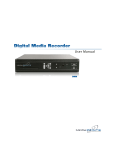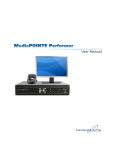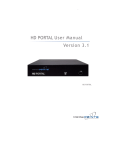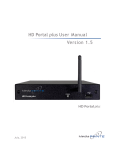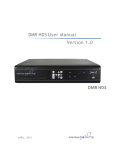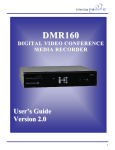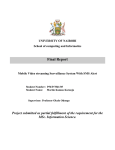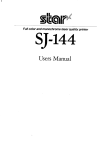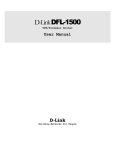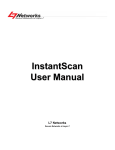Download Media Pointe DVP User manual
Transcript
Digital Video Player User Manual DVP An Advanced Media Design Technology DVP | Digital Video Player ©2009, Advanced Media Design, Inc All rights reserved. This document contains information that is proprietary to Advanced Media Design, the manufacturer of all MediaPOINTE® products. No part of this publication may be reproduced, stored in a retrieval system, or transmitted, in any form, or by any means, electronically, mechanically, by photocopying, or otherwise, without the prior written permission of Advanced Media Design, Inc. Nationally and internationally recognized trademarks and trade names are the property of their respective holders and are hereby acknowledged. MediaPOINTE® is a registered trademark of Advanced Media Design, Inc. Disclaimer The information in this document is believed to be accurate and reliable; however Advanced Media Design, Inc. assumes no responsibility or liability for any errors or inaccuracies that may appear in this document, nor for any infringements of patents or other rights of third parties resulting from its use. No license is granted under any patents or patent rights of Advanced Media Design, Inc. This document was written by the Development Department of Advanced Media Design, Inc. We are fully committed to, and take pride in maintaining high quality documentation. We welcome and appreciate any comments or suggestions you may have regarding content, presentation, structure and distribution of this document. Please use the contact information below for all correspondence: Development Department Advanced Media Design, Inc. 667 Rancho Conejo Blvd.. Newbury Park, CA 91320 USA [email protected] Version 4.0 ii | DVP User Manual 4.0 August 2009 Safety Precautions For your protection, please read all related safety instructions, observe all warnings and precautions, and exercise common sense while operating this electronic equipment. • Always place the unit on a stable cart, stand or table. • Do not use the unit near water or sources of heat. • Do not drop or shake the unit. Do not place or install the unit in environments where it can be dropped or shaken. Make sure the unit is powered off while being moved even for short distances. • Observe the power requirements of the unit; if you are not sure of the power available, consult your local dealer or power company. • When plugging into a power outlet, insert the plug firmly into the outlet. Route the power cord so as to avoid any activity that may result in fraying or other damage to the cord or the plug. • Under no circumstances should you attempt to override the polarization or grounding protection on the plug. • Do not overload wall outlets, integral convenience receptacles or extension cords. • Unplug the unit from the wall before cleaning. Do not use liquid or aerosol cleaners. • For proper ventilation, do not block the slots and openings. Do not install the unit in a location where the ventilation slots and openings can be plugged during everyday use. • Do not place or install the unit under, on top of or near any heat-producing equipment (i.e. radiators, stoves, or amplifiers), or in a heated place. • Unplug the unit during lightning storms, when it will not be used for extended periods of time, or before you have a scheduled power outage. If the unit is visibly damaged either by not observing the precautions above or for any other reason, contact your local dealer immediately. If the unit does not operate to the specifications set forth in this user guide, or exhibits a distinct change in performance, this may be an indication of a problem needing repair. Environmental Operating Limits of DVP Operating Temperature: 0°C to 32°C (32°F to 90°F) Relative Humidity: 10% to 90% non-condensing Storage & Transport Temperature: -20°C to 80°C (-4°F to 140° F) Electrical requirements Input: 100-240V ~50/60Hz Service Support and Training MediaPOINTE®, Inc. is committed to providing the service support and training needed to install, manage, and maintain your MediaPOINTE® equipment. All MediaPOINTE® products are sold through a wide network of Authorized MediaPOINTE® Dealers. For help with your products, contact your local dealer for assistance first. If for any reason, you would like to contact MediaPOINTE® directly for information regarding service programs and extended warranty information, training, installation or usage, we are glad to be of assistance. You can contact us at the phone number listed below, or visit our website. MediaPOINTE® Technical Support Hours: 8:30 a.m. – 5:30 p.m. Pacific Standard Time (866) 709-0444 TOLL FREE (805) 214-7911 INTERNATIONAL [email protected] DVP | iii DVP Package Contents • 1 - MediaPOINTE DVP • 1 - CAT-5e LAN Cable • 1 - AC Power Cable • 1 – Male DVI-D Cable • 1 – IR Remote Control plus 2 AAA batteries • Documentation CD-ROM • Warranty Document • Registration Sheet iv | DVP User Manual 4.0 August 2009 Warranty MediaPOINTE warrants that the DVP (but excluding spare parts and consumables) will be free from any defect in materials or workmanship, and shall perform in accordance with its specification. MediaPOINTE’s sole liability for breach of this warranty will be (at its option) to repair or replace the defective DVP or component thereof. Customer may not return defective product to MediaPOINTE until authorization has been given. MediaPOINTE shall not be liable for any loss of profits or incidental or consequential loss for whatever reason. Warranty on the DVP may be voided under the following circumstances: •If the unit becomes defective resulting from transportation damage. •Damage caused by incorrect storage. •Damage caused by incorrect operation. •Damage caused by incorrect handling. •Use or maintenance in an environment not conforming to the instructions or product specifications of MediaPOINTE. •Product which is altered or modified such as by the removal or replacement of parts and stickers. •Minor electrical or mechanical maladjustments. •Missing or defaced product labelling. •Damage caused during installation or removal. •Units that have been determined as being stolen or scrapped. Document Conventions The following conventions are used throughout this user’s guide. The hand symbol indicates a note, containing special instructions, and in some cases, circumstances that require caution. The light bulb symbol highlights suggestions or hints. The high voltage symbol is intended to alert the user to the presence of un-insulated, dangerous voltages. Table of contents | Table Of Contents About this guide Disclaimer. . . . . . . . . . . . . . . . . . . . . . . . . . . . . . . . i Safety Precautions. . . . . . . . . . . . . . . . . . . . . . . . . . . . . ii Services & Support . . . . . . . . . . . . . . . . . . . . . . . . . . . . ii Package Contents . . . . . . . . . . . . . . . . . . . . . . . . . . . . iii Warranty. . . . . . . . . . . . . . . . . . . . . . . . . . . . . . . . iv Document Conventions . . . . . . . . . . . . . . . . . . . . . . . . . . iv 1 Digital Video Player Introduction & Overview Introduction . . . . . . . . . . . . . . . . . . . . . . . . . . . . . . . . . 1 Sample Configuration . . . . . . . . . . . . . . . . . . . . . . . . . . . . . 1 Front Panel View. . . . . . . . . . . . . . . . . . . . . . . . . . . . . . . 2 Power Switch. . . . . . . . . . . . . . . . . . . . . . . . . . . . . . . 2 IR Receiver. . . . . . . . . . . . . . . . . . . . . . . . . . . . . . . . 2 USB port. . . . . . . . . . . . . . . . . . . . . . . . . . . . . . . . . 2 Rear Panel View. . . . . . . . . . . . . . . . . . . . . . . . . . . . . . . 2 DC Power Connector. . . . . . . . . . . . . . . . . . . . . . . . . . . . 2 Audio . . . . . . . . . . . . . . . . . . . . . . . . . . . . . . . . . . 2 LAN/ Ethernet. . . . . . . . . . . . . . . . . . . . . . . . . . . . . . . 2 USB 2.0/1.1 (STD. Type A). . . . . . . . . . . . . . . . . . . . . . . . . 2 S-Video. . . . . . . . . . . . . . . . . . . . . . . . . . . . . . . . . 2 HDMI. . . . . . . . . . . . . . . . . . . . . . . . . . . . . . . . . . . 2 DVI. . . . . . . . . . . . . . . . . . . . . . . . . . . . . . . . . . . 2 Serial RS-232 Port. . . . . . . . . . . . . . . . . . . . . . . . . . . . . 2 DVP Specification. . . . . . . . . . . . . . . . . . . . . . . . . . . . . . . 3 2 Access & Network Setup 4 Logging In. . . . . . . . . . . . . . . . . . . . . . . . . . . . . . . . . . 4 Web Portal Access. . . . . . . . . . . . . . . . . . . . . . . . . . . . . 4 Administrator Access. . . . . . . . . . . . . . . . . . . . . . . . . . . 4 vi | TABLE OF CONTENTS Changing Administrator Password. . . . . . . . . . . . . . . . . . . . . 4 User Access. . . . . . . . . . . . . . . . . . . . . . . . . . . . . . . . 5 User Login Security. . . . . . . . . . . . . . . . . . . . . . . . . . . . 5 Author Access. . . . . . . . . . . . . . . . . . . . . . . . . . . . . . . 5 Author Login Security . . . . . . . . . . . . . . . . . . . . . . . . . . . 5 Network Configuration. . . . . . . . . . . . . . . . . . . . . . . . . . . 5 System Name. . . . . . . . . . . . . . . . . . . . . . . . . . . . . . . 6 IP Settings . . . . . . . . . . . . . . . . . . . . . . . . . . . . . . . . 6 Static IP Address. . . . . . . . . . . . . . . . . . . . . . . . . . . . . 6 DHCP Address. . . . . . . . . . . . . . . . . . . . . . . . . . . . . . . 6 Configuring IP via USB. . . . . . . . . . . . . . . . . . . . . . . . . . . 6 3 System Management Tools 8 AV Controls . . . . . . . . . . . . . . . . . . . . . . . . . . . . . . . . . 8 Audio Setting. . . . . . . . . . . . . . . . . . . . . . . . . . . . . . . 8 Video Setting . . . . . . . . . . . . . . . . . . . . . . . . . . . . . . . 8 AV Test. . . . . . . . . . . . . . . . . . . . . . . . . . . . . . . . . . 8 Date & Time. . . . . . . . . . . . . . . . . . . . . . . . . . . . . . . 8 Command Line . . . . . . . . . . . . . . . . . . . . . . . . . . . . . . 9 RS-232. . . . . . . . . . . . . . . . . . . . . . . . . . . . . . . . . . 9 SMTP Mail. . . . . . . . . . . . . . . . . . . . . . . . . . . . . . . . 9 Notifications. . . . . . . . . . . . . . . . . . . . . . . . . . . . . . . 9 Logging. . . . . . . . . . . . . . . . . . . . . . . . . . . . . . . . . 9 Update. . . . . . . . . . . . . . . . . . . . . . . . . . . . . . . . . . . 10 Software Update. . . . . . . . . . . . . . . . . . . . . . . . . . . . . 10 Reset Configuration. . . . . . . . . . . . . . . . . . . . . . . . . . . 10 System Info. . . . . . . . . . . . . . . . . . . . . . . . . . . . . . . . . 10 Shutdown. . . . . . . . . . . . . . . . . . . . . . . . . . . . . . . . 10 Reboot. . . . . . . . . . . . . . . . . . . . . . . . . . . . . . . . . 10 4 Channels & Media Control 11 Video On Demand Channel Settings. . . . . . . . . . . . . . . . . . . . 11 Viewing a Video On Demand Channel. . . . . . . . . . . . . . . . . . . 11 Live Streams. . . . . . . . . . . . . . . . . . . . . . . . . . . . . . . 11 Archives. . . . . . . . . . . . . . . . . . . . . . . . . . . . . . . . . 11 1 DVP | DVP Introduction & Overview Introduction Welcome to the user’s guide for the MediaPOINTE® Digital Video Player (DVP). The DVP is one of the smiplest most cost effective professional media player in the market. It is capable of receiving media content via IP/LAN line from other AMD archivers/streamers (e.g. DMR, DMR HD, and VIdi HD) and playing it locally on a PC monitor or a nearby LCD TV, big screen projector, etc. with the same audio and video quality and resolution of its source. This user’s guide describes how to set up and use the DVP to play, transport graphics, video and audio content over IP networks. As with all MediaPOINTE AVover-IP products, you can control the DVP by different methods. These methods include Web Portal interface, remote control, RS-232 serial ports, and Telnet. This guide is written for units running 4.0 software. If the DVP is operating on a different version of software, some capabilities and screenshots may be different. Key Applications The DVP player can be used in a variety of situations for live communication and collaboration. Such as: • Play live streamed or archived media content from multiple AMD archivers/streamers sources. • Play visual information, designs, and concepts with dispersed groups of people to gather input during a video conference • Play important videoconferences to other locations such as overflow rooms or remote conference locations over your corporate network or stream archived or live employee training sessions across vast geographical areas. • Play research discussion, engineering, architecture, product design, or process analysis when the participants are not able to meet in one central location. Sample Configuration The DVP is an AV-over-IP player. It receives the audio/ video input content via IP/LAN line. The video outputs consist of DVI-D, analog RGB, S-Video, HDMI. The audio outputs consist of Stereo, Line level, and 3.5mm Jack (PC audio type). This player supports NTSC and PAL standards. The DVP is capable of linking up or channeling to other AMD product (e.g. DMR, DMR HD, and VIdi HD). Once the channels between them established, the user is able to view and play archived or live streamed content from a variety of AMD archivers/streamers. The media can be viewed via local PC monitor or a TV monitor if desired. Please see chapter 4 for information on Channels setup. | DVP User Manual 4.0 August 2009 1 2 3 Front Panel View (above) The front panel consists of a power switch, IR receiver, and an USB port. 1. Power Switch Rear Panel View (below) 1. DC Power Connector - Input 100-240 VAC 50/60Hz external power supply with 12VDC–3A output. This POWER button on the front of the unit will turn the unit on and off. It is used in conjunction with the main power switch on the rear of the unit. 2. Audio - Three audio outputs consist of Stereo, Line level, and 3.5mm Jack (PC audio type) 1. Ensure power supply switch is in the ON position 2. Start the unit by pressing the POWER button 4. USB 2.0/1.1 (Std. Type A) - The two USB ports can be used for network configuration of the DVP. For more information on USB network configuration, see chapter 2. 2. IR Receiver 5. S-video - One S-video output The IR Receiver is used with the included remote control. 6. HDMI - One HDMI output (on back panel) 3. USB Port The USB port can be used to offload media from and to the DVP. It can also be used to set or capture an IP address. See the Network Configuration section for USB IP address configuration. Use this information when you first purchase the DVP and when you are ready to install the hardware at your site. To turn on the unit ensure the power supply switch is in the ON position then start the unit by pressing the POWER button. 3. LAN/Ethernet - 10/100 Mb (RJ-45) input 7. VGA - HD-15 Female output connector for local monitor. NOTE: THIS IS NOT A PC LOOP-THROUGH 8. DVI - One DVI output 9. Serial RS232 Port - Two DTE Male DB-9 connectors used to attach a computer or other equipment for serial control. 7 9 8 5 6 3 4 1 2 DVP | DVP Specification PLAYBACK RTSP stream from channeled MediaPOINTE appliances OUTPUTS Line level 3.5” Audio output DVI VGA S-Video HDMI NTSC or PAL RESOLUTIONS & FRAME RATES Plays native resolutions and frame rates from source stream NETWORK INTERFACES 1 x Ethernet (10/100/1000 MBit) PROTOCOLS HTTP, TCP/IP, FTP, UDP, RTSP, SMTP, DHCP, NTP. Uses channels to communicate wiith DMR, DMR HD, & VIDi HD SYSTEM MANAGEMENT HTTP Web Portal Application Interface (API) for custom web applications RS232 control telnet control OSD w/ IR controller IE6 SECURITY Two user level accounts ENVIRONMENTAL DATA Operating temperature: 0º C to 40º C (32º F to 104º F) Relative humidity: 10% to 90% Storage and transport temperature: -20º C to 80º C (-4º F to 140º F) non-condensing POWER Input 100–240VAC, 50–60Hz, 250W max. external power supply Output 12VDC–3A PHYSICAL DIMENSIONS 1/2RU Height: 3.5” (89mm) Width: 19” (483mm) Depth: 14” (355mm) 19” rack mountable, 2U height | DVP User Manual 4.0 2 August 2009 Access & Network Setup Logging Setup In Administrator Access This section describes the procedure for athe first Use this information when you first purchase DVPtime and login, andare theready DVPto access when you installrights. the hardware at your site. This The Administrator maintains all rights to the DVP. section shows the back panel and explains how to connect the separate input connections to the unit. The default IP address is: 192.168.1.253 Web Portal Access: When the unit is initially accessed, it will default to a “guest” user access however, you’ll need to click on the LOGIN menu item to initiate another login launcher. To log into the DVP, browse to its IP address using your Internet browser. There are three levels of access rights. There is a “user” login, an “author” login, and a system “admin” login. 1. If you are already logged into the DVP as a user or author, click on the LOG IN selection at the top of the main menu. You will be prompted to enter a username and password. 2. Use the login id “admin”. The default password is “MediaPOINTE”. Note that the login id and the password are case sensitive. 3. From the Security selection of the main menu, the Administrator can enable or disable logins for users and authors and can change the admin password. Changing the Administrator Password Administrator rights are required to access or change any of the settings under the “Configure” and “Manage” sections in the main menu. These sections include: Config IP, Security, Update, and System Information. By default, the Administrator ID and password are set to “admin” and “MediaPOINTE” respectively. It is not possible to change the Administrator ID. It will always be “admin”. To change the Administrator password, enter a new Administrator password in the “New admin Password” field (10 characters maximum) and confirm it by clicking Change Admin Password button. The next time the DVP is accessed, the new admin password will take effect. Be sure to write down the new administrator password and keep it in a safe place. If you forget the admin password, the DVP will have to be reset back to the factory defaults to enable an administrator to access the “Configure” and “Manage” sections of the unit. User Access The user has the ability to view existing content on the DVP. 1. Once you have navigated to the site, you will be presented with the default menu page. Anyone who logs into the DVP is considered a ‘Guest’ user until they complete the admin login. Administrative login is required to make changes to the system settings under the “Configure” and “Manage” sections of the menu. If all you wish to do is playback content from the DVP you will not need administrator rights. No password is required for the standard Guest user login as a default. However, the administrator has the ability to modify this feature to require a password for viewers to login. 2. In order to change the default IP settings of the DVP or any of the other configuration settings, you must log in with administrator rights. User Login Security By default, user security is turned off. Anyone can LOGIN to the DVP without being asked for a login ID or password. Checking the Enable user security checkbox will enable security for the user. This will require all users to have an ID of “user” and the password created in the “user password” field. Enter a user password in the “user password” field and confirm it by clicking the Save user Security Settings DVP | button. The next time the DVP is accessed, anyone logging in will be presented with a login box asking for the ID “user” and a password. Un-checking the Enable user security checkbox will restore the default settings. Author Access The Author maintains content creation rights on the DVP. The Author can set recording options but does not have access to the “Configure” and “Manage” sections of the menu. 1. If you are already logged into the DVP as a user or admin, click on the LOG IN selection at the top of the main menu. You will be prompted to enter a username and password. 2. Use the login id “author”. The password will be user defined in the User Security section of the main menu. Note that the login id and the password are case sensitive. Author Login Security Author rights are required to access or change any of the settings under the “Options” section in the main menu. By default, the author login password is disabled. Checking the Enable author checkbox will enable the author login security. Enter an author password in the “author password” field and confirm it by clicking save author Security Settings button. Un-checking the Enable author LOGIN checkbox will deactivate the need for an author login password Network Configuration The System Name and all network configurations can be set in the IP Settings menu page. Network settings may also be configured via USB memory stick. | DVP User Manual 4.0 August 2009 System Name Static IP Address The factory set system name is the unit build number. You can change the name in the IP setting menu page by entering a new name in the text field. A reboot is required for the new name to take effect. The name can be up to 15 characters long and consist of alphanumeric characters. No special characters or symbols will be accepted except for a hyphen. To set a Fixed (Static) IP address, follow the procedure below. IP Settings 1. Connect the Ethernet / LAN cable and power up the DVP. 2. On your Internet browser, enter the current IP address of the DVP. (Note: If the unit has factory settings, the default static IP address is: 192.168.1.253) 3.Login to the DVP using the procedure shown in the Logging In section. 4. Navigate to the network settings page by selecting IP Settings. 5. In order to change to a Fixed or Static IP address, set the DHCP Client checkbox to “Disable”. Fill in the IP Address, IP Subnet Mask and Default Gateway fields. Once you have completed all of the above steps, select the Apply Changes button. You will receive a pop-up window warning you to use this option with caution as you are changing the default address and should remember the new settings. The System Name and all network settings can be set in the IP Settings section of the main menu. Network settings may also be configured via USB memory stick configuration. To quickly find the system’s IP Address, connect a VGA (RGBHV) or DVI monitor to the output. Use the keypad to navigate to the System Info page of the on screen menu. IP addresses may be assigned to the DVP by two ways: DHCP and Fixed (Static) IP. If your network is configured for DHCP, the IP address will be provided automatically and will be visible on the video output of the DVP on power up. Network Configuration Setting Description DHCP Client Enable DHCP settings for automatic address retrieval f rom DHCP Server. Disabling the DHCP client will require a static IP address (with subnet mask and default gateway) to be entered. IP Address Assign a static IP address to DVP. This field will also display the currently assigned IP address IP Subnet Mask Assign subnet mask to DVP. This field will also display the currently assigned subnet mask Default gateway Assign a default gateway to the DVP. This field will also display the currenty assigned default gateway DNS server If the network supports DNS, enter the DNS Server Address(es)) here. Note: The new IP settings will take place immediately DHCP IP Address 1. Follow the same steps as above (1 thru 4) 2. To allow the DVP to pick up an IP address, set the DHCP Client checkbox to “Enable”. 3. If you have made any changes to the network settings, select the Apply Changes button. You will receive a pop-up window warning you that you to use this option with caution as you are changing the default address and should remember the new settings. Configuring IP via USB The network parameters of the DVP can be set via a special configuration text file on a USB memory stick. Insert the memory stick into one of the DVP USB ports at any time. The unit will look for the presence of this configuration file and will implement the settings from the file. Use a simple ASCII text editor to create the file. DVP | This file must be placed on the root of the USB drive. This file must be named dmx_ip_conf.txt and must have the following format (note: the fields in RED should be configured for your network settings). dhcp=(bool)0 dns_1=(string)192.168.0.2 dns_2=(string) 192.168.0.3 ethernet=(string)auto gateway=(string)192.168.1.1 ipaddress=(string)192.168.1.253 netmask=(string)255.255.255.0 If the dmx_ip_conf.txt file is intentionally left blank with no text of any type within the body of the file, the DVP will write its network settings to this file. This is an easy way to obtain the unit’s network settings. | DVP User Manual 4.0 3 August 2009 System Management Tools d ea Toolbar The DVP can be controlled by several different methods. These include, a Web Portal interface, IR remote control, contact closure, RS-232 serial port, Telnet, or by the convenient button panel (Keypad) on the front of the unit. This section will cover each of these control interfaces in detail. AV Controls Audio setting In the AV Control menu page, audio input and output levels can be adjusted either by sliding the pointer along the bar, or by entering a value from 0 to 100 in the text field. You can also mute the output by clicking on the icons. Event tones can be turned on to alert you when an event occurs. For example you will hear a tone when you stop recording. front panel. The power switch has an internal RED LED that will turn on when the power is activated. • The DVP has a fully featured Web Portal that can be accessed via a web browser once the unit has booted up. Enter the unit’s IP address in the web browser’s address bar to access the main menu. Then, navigate to and click on the AV Test menu page. . • There you can click on various video test patterns and audio clips to test AV output. When done, click on STOP TEST to suspend the AV test. Each of these tests will auto-suspend it-self after 10 seconds of being initiated. Video Setting Display Settings (AV Controls menu page) Setting Description Aspect Ratio The aspect ratio of the output can be specified to be either 4x3 or 16x9 Media Player Status When enabled overlays the elapsed and duration time of the media file during playback on the DVP AV Test Navigate to the AV Test menu page and begin by making the following connections to the back panel of the DVP: • Begin first by plugging in the network control cables (i.e. Ethernet, and RS-232) • Plug in all of the output connections (i.e. VGA, DVI, S-Video, and HDMI) • Finally, plug in the power cable connector and turn the unit on by pressing the power switch located on the Date & Time When content is recorded using the DVP, it is given a time and date stamp. These can be set in the Date & Time menu page. The date can be selected from a popup calendar. Confirm any changes by clicking on the Set Date & Time button. If desired, the NTP (Network Time Protocol) feature can be enabled to synchronize the clock of the DVP to an NTP server; click on the “Enable NTP” box and enter the server information, then click on Save NTP settings DVP | Command Line DB-9 Female Navigate to the Command Line menu page to set the command line interface that can be accessed from Telnet or RS-232. A list of these commands Function DB-9 Female 2 Rx to Tx 3 3 Tx to Rx 2 5 Signal Ground 5 Telnet (TCP/IP) The Telnet port by default is disabled. To turn on Telnet control, set the Telnet port number (typically Port 23) and check the TCP/IP port enable checkbox. A password for the Telnet session can be enabled by entering a password in the Password for TCP/IP connection text box. If a password is not desired on the Telnet session, leave the text box blank. To access the telnet client, open a command prompt on your computer and enter: telnet <ipaddress> Once connected to the DVP, a connect message will be displayed. DVP Welcome to MediaPOINTE Password:_ Once logged in, type ‘help’ or ‘?’ for a list of commands. You can also see below for a list of the available commands. bye quit cli displayratio help ? ipassign ipset key log netstat notify ntp play playstatus reboot resetconf shutdown smtp status sysinfo test usersec volume RS-232 On the back of the DVP there are two serial control ports configured as a DTE that supports the RS-232 protocol. A Null-Modem cable should be used between the DVP and the COM port on your PC. Terminal session settings required for RS-232 control are: 9600, 8, None, 1 with No Flow Control. There is no password protection on this interface and, by default the RS-232 port is enabled. The administrator has the ability to disable the port by unchecking the COM port enable checkbox. SMTP Mail The DVP has the ability to send email messages to a remote SMTP server. Enter the address of the SMTP server in the appropriate text box (use the IP address if DNS settings are not set). The Email field will set the default “From” field to the entered email. Leave this field blank to allow the user to enter their own “From” email address. Confirm any changes to the SMTP mail configuration by clicking Save SMTP settings button. Notifications The DVP can be configured by the Administrator to send email event notifications from the Notifications section of the main menu. • First, navigate to the SMTP Mail menu page to enable SMTP mail and fill in the mail server and mail author information (if not already set) then confirm these settings with the Save SMTP settings button. • Next, navigate to the Notification menu page and enter the email address to which the notifications will be sent and select the events to track. Confirm these settings with the Save Notification Settings button. Logging The DVP can be configured by the Administrator to log events from the Logging section of the main menu. Select the events you wish to save to a log and confirm these settings with the Save Logging Options button. LOGS (Notification menu page) Log name Description Event Log The time and date of all media play of live streams or archived content are captured in this log Failed Logins All failed logins attempts are logged and date stamped SMTP Log All e-mails sent from DVP are logged and date stamped Current logs will hold 14 days of data. Logs listed as “old” will include the previous 14 days of data. 10 | DVP User Manual 4.0 August 2009 Update System Info The Update section of the DVP menu enables the system administrator to perform several key functions. These include upgrading the system software to a new version; and resetting the DVP configuration to factory default network settings. The System Information section gives the user important information about the DVP. The system can be shutdown or rebooted from this page of the DVP. See the table for more details. Software Update MediaPOINTE’s Development Team is constantly striving to refine and upgrade features on the DVP to lead technological advances in the archiving and streaming marketplace. In order to keep the DVP up to date with all of the latest features, you may want to update the system software from time to time. Follow the following steps to upgrade the DVP software. • Contact your MediaPOINTE dealer for the latest software version. This file will have an *.mpup extension. The downloaded file must be placed on the same network as the PC that will be used to browse the web portal. • Go to the Update section of the main menu and click on the browse button to search for the downloaded *.mpup file. Locate the file and specify the path to the file as shown in the window. • Select the Upgrade button to begin the upgrade. Be sure to wait until the upgrade is complete before proceeding. • If your DVP doesn’t automatically reboot, manually do this by selecting the Reboot button in the Info section. This will reboot the unit and the new software will be in place. Reset Configuration Selecting the Reset Configuration button will reset all DVP passwords and network settings to factory default. This will not delete any of your recorded files. This is the same as using the reset button within the hole on the front on the DVP. SYSTEM INFORMATION (info menu page) Setting Description Product Name Name of DVP Series Product Series Number Version The installed version number of current software Serial Number The DVP Serial number Manufacturer Name of the manufacturing company Copyright Copyright date of the DVP Available disk space The amount of disk space still available for media content recording SDI This is a unique identifier specific to each DVP. Provide MediaPOINTE technical support with this number should you call to start a ticket Options Future Optional Features will be listed here Option Keys This key will be required to activate an option Shutdown Select the Shutdown button to remotely power-down (shut off) the DVP. Any access to the unit will be lost as the unit is powered down. In order to power up the unit, the user must physically push the power switch on the front of the unit. No communication is possible with the DVP when it is powered down. Reboot Select the Reboot button to power off the DVP and then turn the unit back on. This is a useful option after changing passwords or IP Addresses. DVP | 11 4 Channels & Media Control The DVP is capable of channeling or bridging over the network to other channeled or bridgeable AMD product (e.g. DMR, DMR HD, and VIdi HD) to view/play archived content, and or play live streams. Viewing a Video-On-Demand Channel The following table describes AMD devices’ play/stream VOD capabilities: Video-On-Demand Channel Product Matrix Video-On-Demand Channel Settings Capabilities Description DMR DMR HD DVP VIDi HD VIDi HD-d A Video-on-Demand channel is a way to link up to a like optioned DMR, DVP, DVP, VIDi HD-d, and VIDi HD units simultaneously. By clicking on “Add New Channel” a window will open allowing you to enter the IP address of the device you want to connect to. View/Play recorded content from Yes Yes No No No View/Play live stream from Yes Yes No Yes No It is important to mention that if a DVP for example is Web Porting into a DMR-HD that the DMR-HD Channel settings has allowed the live streams viewing and archived media playback. Otherwise, the DVP will not be able to make a proper channel linkage. If a password has been set for Channel access into the DMR-HD, then the DVP will need to provide it as well to be able and channel to it. Make recorded content available to Yes Yes Yes No No Stream live content to Yes* Yes* Yes No Yes * With Video-On-Demand Option enabled Live Streams Navigate to the Live Streams menu page you will see current live streams from all your VOD channels. To view the stream click on the play icon under Actions and a window will open and display the stream. Archives Navigate to the Archives page to start and stop a previously archived material from other channeled media sources. Simply selecting the desired recorded media and then clicking the play locally button will start the content playback. After filling in the IP address of the media source, typing in the password if applicable, and clicking on the “Add Channel” button, you will be able to view any and all channeled units simultaneously. During playback, the pause, stop, skip forward and skip backward controls will be provided. To play content on the local PC that is browsing the DVP click on the Play button. In order to play the file, an MPEG-4 capable playback application (such as Quicktime Player) is required on the viewing PC. DVP An Advanced Media Design Technology Technical Support 805.214.7911 [email protected] Main Office 667 Rancho Conejo Blvd. Newbury Park, CA 91320 805.480.3700 www.mediapointe.com




















